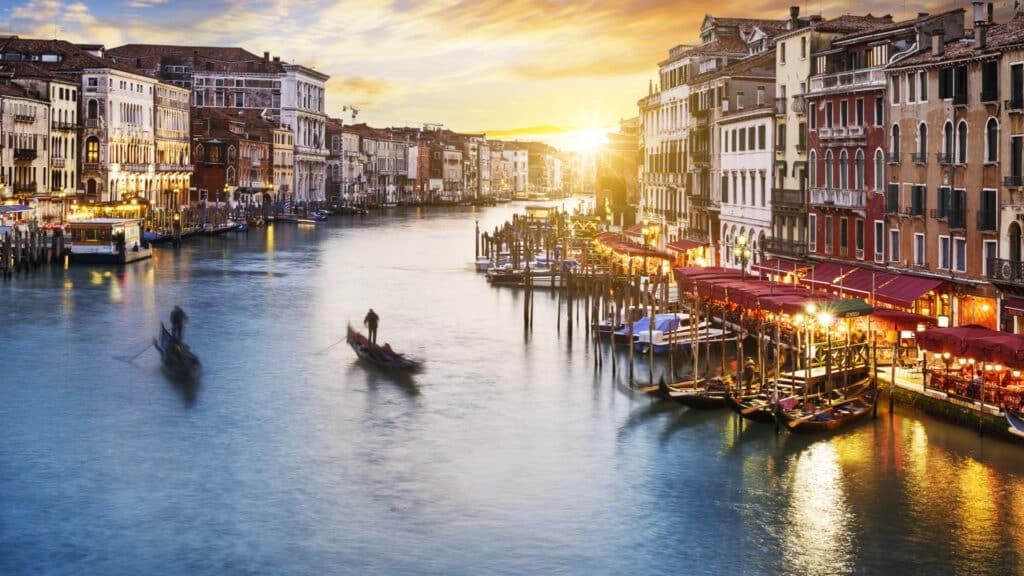The City of Canals. The Floating Beauty. Land of gondolas, glittering water, and tourists balancing gelato while crossing tiny bridges. Whatever you call it, Venice is one of those rare cities that feels like nowhere else on Earth.
With its winding alleys, shimmering lagoons, and centuries of history, Venice is home to the famous landmarks everyone knows. Beyond St. Mark’s Basilica and the Rialto Bridge, there is a maze of quiet squares, hidden courtyards, and secret spots where daily life carries on much as it has for centuries.
But beyond the postcard views and Instagram-famous spots, what exactly should you do in Venice?
In this article, we’ve put together a list of 11 experiences that will help you see Venice the way it deserves to be seen.
Take a Gondola Ride Through the Canals

Riding a gondola in Venice is something you just have to try at least once. Yes, it’s a bit touristy, but there’s nothing quite like floating through the canals in one of these classic black boats. Gondolas have been around for centuries, carrying people through Venice’s waterways long before there were motorboats.
The best time to ride is just before sunset, when golden light hits the buildings and reflections dance on the water. It’s peaceful, romantic, and offers a completely different view of the city.
Prices are regulated by the city. A standard gondola ride costs around €90 for 30 minutes during the day and €110 in the evening. That’s per boat, not per person, and each gondola can hold up to five people. Only cash is acceptable. You’ll spot gondolas all over, so no need to book ahead unless you’re short on time.
Travel Tip: Skip the super crowded Grand Canal and ask your gondolier to take you through the quieter, hidden canals instead. It’s more charming and less chaotic. You can even request a singing gondolier for a classic touch. Just expect to pay a little extra.
Visit St. Mark’s Basilica and Climb to the Terrace
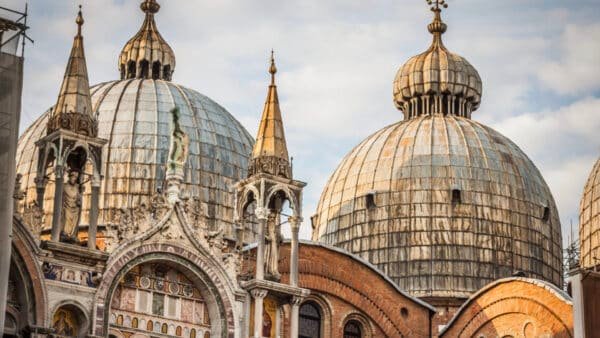
St. Mark’s Basilica (Basilica di San Marco) is Venice’s most famous church and a must on any visit. Built in the 11th century, its design was inspired by a church in Constantinople. Step inside, and you’ll be amazed by the golden mosaics that took centuries to complete. It’s hard not to be amazed when you see every inch of the domes and ceilings glittering in gold. To visit the main basilica, tickets cost €3, or €6 if you book online to skip the long queues.
After visiting the interior, don’t miss the chance to climb up to the Loggia di Cavalli (terrace). The elevator ride saves you from climbing 323 steps. From the top, you get an incredible view over St. Mark’s Square, the Doge’s Palace, and the lagoon beyond. The terrace also lets you see the famous bronze horses up close.
Go early in the morning to enjoy the square without the crowds, then come back later to explore inside. Dress modestly, as it’s still an active place of worship, and bring cash for small extra entry fees if you want to see more areas like the Pala d’Oro or the bell tower.
Tour the Doge’s Palace and Cross the Bridge of Sighs
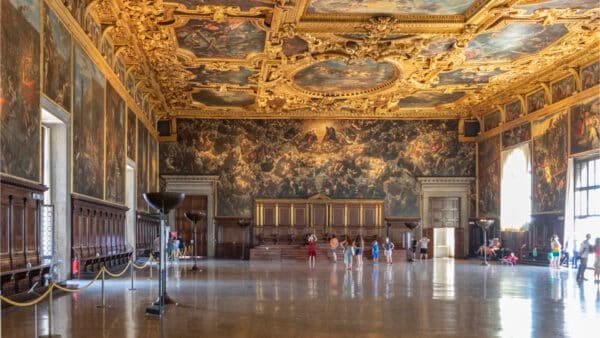
Next to St. Mark’s Basilica, you’ll see a beautiful pink and white building: the Doge’s Palace. The Doge’s Palace (Palazzo Ducale) was once the home of Venice’s rulers, the Doges, and the heart of political power in the city.
Today, it is a beautiful museum where you can see grand halls filled with art, ornate ceilings, and stories of intrigue. The lavish Senate and Council chambers, with gold accents, carved wood, and huge frescoes by masters like Tintoretto and Titian, are a feast for the eyes.
One highlight is the Bridge of Sighs, which connects the palace to the old prison. The name comes from the sighs prisoners supposedly let out as they took one last look at the city before being locked away. Crossing it today, you’ll see the same view, though without the tragic ending.
Some tours, like the Secret Itineraries Tour, include access to secret passageways and hidden rooms where sensitive political decisions were made. Tickets cost €25–30 if booked in advance and also include entry to other museums in Piazza San Marco. For fewer crowds, visit in the evening (open until 11 pm on summer weekends).
Take a Water Bus (Vaporetto) Trip

The vaporetto is Venice’s public bus system, but these buses float on water instead of driving on roads. These water buses shuttle locals and visitors between the city’s main sights, but they’re also one of the cheapest ways to enjoy a Grand Canal cruise.
The most scenic route is Line 1, which travels slowly down the Grand Canal. Start at Piazzale Roma and ride all the way to St. Mark’s Square. Along the way, you’ll pass under the Rialto Bridge, glide by centuries-old palaces, and get a front-row view of Venice’s lively waterfront. If you want to go even further, the same line continues across the lagoon to Lido Island. It runs both directions, so you can also start from Lido and head into Venice for a grand entrance.
Tickets cost much less than a gondola, and the ride gives you a great feel for the city’s layout. For fewer crowds, hop on in the late afternoon and travel toward St. Mark’s; most people will be heading the opposite way.
Watch Glassblowing in Murano
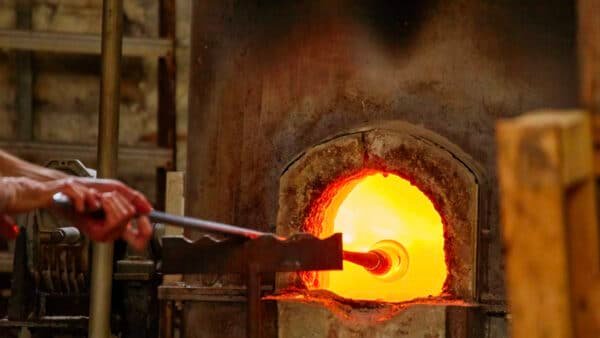
Murano is just a short vaporetto ride from Venice, about ten minutes from Fondamente Nove to the stop at the southern tip of the island. The area is larger than many expect, with smaller islands connected by bridges and even a big park at the northern end.
Most people come for one thing: Murano glass. While the glassmaking tradition isn’t as strong as it once was, you can still see skilled artisans at work, shaping molten glass into delicate pieces using nothing but a blowpipe and hand tools. The easiest option is the Glass Cathedral, right near the vaporetto stop, where demonstrations happen every 45 minutes.
After the demo, browse the showrooms, but be aware of tourist traps. Look for signs that say “Vetro Murano Artistico” to make sure you are buying authentic Murano glass.
Murano also has two lovely churches: the Duomo Basilica dei Santi Maria e Donato, famous for its mosaic floors and “dragon bones,” and the Chiesa di San Pietro Martire, home to works by Tintoretto and Veronese.
A relaxing loop walk between these sights is the perfect way to explore before heading back to Venice.
Visit the Colorful Island of Burano
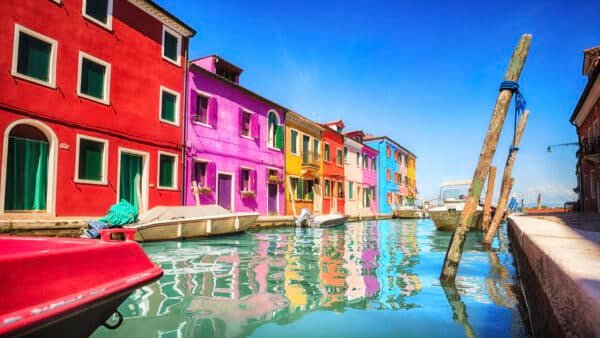
Burano looks like it came straight out of a postcard. This tiny island near Venice is famous for its brightly painted houses. The tradition started so fishermen could see their homes from the water on foggy days. Today, it creates one of the most Instagrammable spots in Italy.
The trip takes time, about 45 minutes by vaporetto from Venice, so we suggest that you have a half-day to spare. You can also combine it with a stop in Murano, since the same boat route goes there.
Burano has a quieter, more local vibe than Murano. The island is also famous for handmade lace. Local women have been creating beautiful lace designs for centuries. You can watch them work and buy authentic pieces from their shops. The Lace Museum explains the history and techniques of this delicate craft.
Be sure to see the leaning bell tower at Chiesa di San Martino. For something extra, cross the small bridge to Isola Mazzorbo, home to scenic vineyards. When it comes to food, Burano has great seafood. The risotto de gò (lagoon fish risotto) is a local specialty worth trying. Also, try some Bussolà, a buttery cookie that is a local favorite. Burano is perfect for a slow-paced escape from Venice’s busier spots.
Visit San Polo (Rialto Market and Rialto Bridge)

San Polo is one of Venice’s six districts and sits right in the middle of the city. It is home to two of Venice’s most famous sights, the Rialto Bridge and the Rialto Market.
Start in San Marco and walk to the Rialto Bridge, the oldest bridge crossing the Grand Canal. Originally made of wood, it collapsed or burned several times before being rebuilt in stone. From the top, you can enjoy stunning views of the canal, especially looking southwest.
After crossing the bridge, walk straight to the Rialto Market. This busy market is best in the morning when local sellers display fresh vegetables, fruit, and spices, and freshly caught fish straight from the lagoon. In spring, you might see the artichokes growing in the lagoon. It is a wonderful place for photos and to see daily life in Venice.
When you finish, wander through San Polo’s quieter streets, visit Campo San Polo, and stop at the Basilica di Santa Maria Gloriosa dei Frari to admire its beautiful art and tall ceilings.
Enjoy Aperitivo and Cicchetti

One of the best ways to experience Venice is to join the locals for aperitivo, the Italian version of happy hour. In the early evening, friends and neighbors gather at small bars to relax, chat, and enjoy drinks before dinner. The most popular drink is the Venetian Spritz. This signature orange cocktail is made with prosecco, a splash of Aperol or Campari, and soda water.
Pair your drink with cicchetti. Cicchetti are small dishes, much like Spanish tapas, enjoyed as a snack or light meal. You can find them all over Venice. They often include small sandwiches, slices of meat or cheese served on bread, or vegetables placed on top of polenta. Try tramezzini (triangular sandwiches), baccalà mantecato (creamed cod), or sarde in saor (sweet and sour sardines).
The best places to enjoy this tradition are bacari, cozy local wine bars found all over the city, especially the Rialto area and the Castello neighborhood. Stand at the counter, chat with the staff, and sample a few different cicchetti with your spritz. It is a fun, relaxed way to taste Venice and feel like a true local.
Explore the Hidden Alleys of Dorsoduro
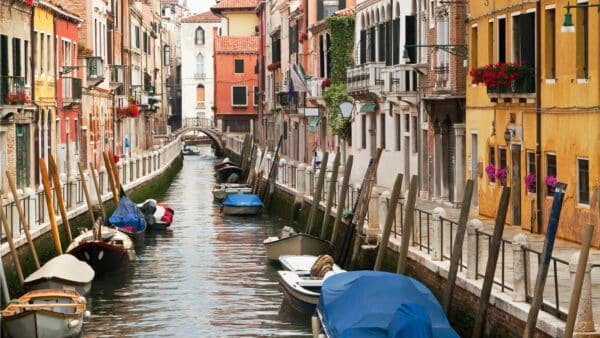
If you want a break from the tourist-packed areas, Dorsoduro in the south of Venice’s historic center is a great stop. You won’t find big crowds, just everyday Venetian life and a relaxed local vibe. It is known as the city’s cultural heart, filled with art galleries, museums, and beautiful streets to wander. Art lovers will especially enjoy this area.
One must-visit spot is the Peggy Guggenheim Collection. It is a modern art museum housed in a former palace along the Grand Canal. The museum has an amazing collection of 20th-century art, with works by famous artists like Picasso, Dalí, Miró, and Kandinsky.
Dorsoduro is also a great place to wander aimlessly. You’ll stumble upon small art galleries, cafés, and local wine bars. Grab a spritz and enjoy it by a canal, no rush, no crowds. As you explore, keep an eye out for Banksy’s “Migrant Child”, painted on a canalside building, one of the photogenic sites. It’s where Venice shows its softer, more local side.
Tour Around the Jewish Ghetto
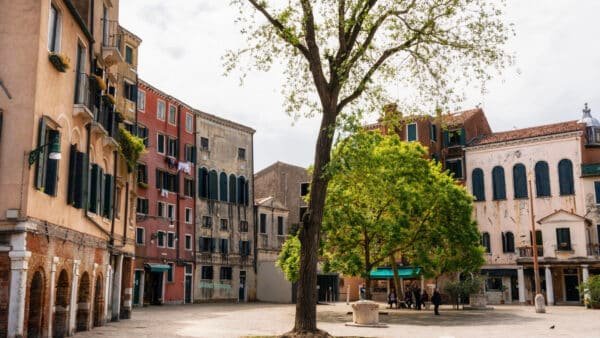
The Jewish Ghetto, located in the Cannaregio district, is one of the most interesting yet often overlooked parts of Venice. It was the first official ghetto in the world, created in 1516, and still has a lot of historical and cultural importance.
Walk through its peaceful squares and narrow alleys, and you’ll find synagogues, kosher restaurants, and small museums that tell the story of Venice’s Jewish community. The Jewish Museum offers guided tours that include visits to the synagogues, many of which are still in use.
Don’t miss looking into the windows of the local bakeries. Some of them still make traditional Jewish-Venetian pastries.
This part of the city is calmer and less busy than the main tourist spots. Visiting the Jewish Ghetto lets you see a part of Venice’s history that many visitors never get to experience.
Climb the Campanile di San Marco

Lastly, to get the best view of Venice, climb (or take the elevator) to the top of St. Mark’s Campanile, the iconic bell tower in Piazza San Marco. From up there, you get a 360° view of the city’s rooftops, canals, and even nearby islands. It’s easily one of the top photo ops in Venice.
The tower stands about 99 meters tall, but you don’t have to walk up all those stairs. There’s a lift that takes you straight to the top. The ticket costs around €10, and it’s totally worth it for the view.
You’ll see how Venice really is a city floating on water. You can spot landmarks like the Basilica, Doge’s Palace, and even the Dolomites on a clear day.
Try to go early in the morning or close to sunset for softer light and fewer crowds. It’s a must-do, especially if it’s your first time in the city.
Wrap Up

So far, you should be convinced that Venice offers experiences that exist nowhere else on Earth. From riding a gondola and visiting St. Mark’s Basilica to exploring the Rialto Market and tasting cicchetti in a local bacaro, each activity is worth trying. You can shop, sightsee, or simply wander through canals and hidden squares. These 11 experiences we discussed in this guide show different and beautiful sides of Venice.
So, which activity will you try first? Or will you plan to experience them all? We’d love to hear your thoughts.
